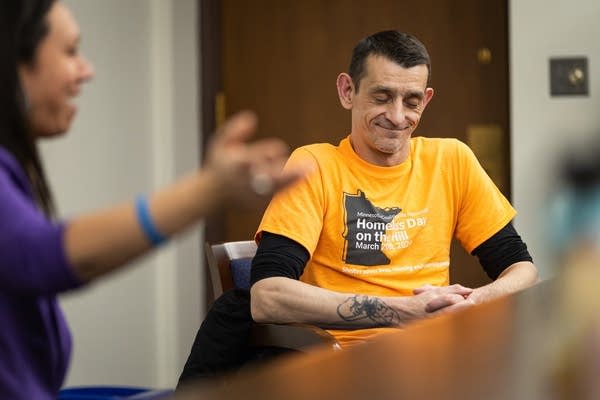Researchers: Homelessness declined slightly in Minnesota since 2018, pandemic effect unclear

Go Deeper.
Create an account or log in to save stories.
Like this?
Thanks for liking this story! We have added it to a list of your favorite stories.
Wilder Research’s 2023 Minnesota Homeless Study found a slight decrease in those experiencing homelessness from 2018.
But the decline “masks year-over-year fluctuations in homelessness particularly due to the COVID-19 pandemic and an unprecedented funding for rental and housing assistance,” researchers said. The count was not conducted in 2021.

Every three years, Wilder Research conducts a statewide survey to better understand the prevalence of homelessness in Minnesota. On a single night in October, more than 1,000 volunteers conducted face-to-face interviews with unhoused people.
Volunteers also counted 10,522 people experiencing homelessness, a 7 percent decrease since 2018.
Turn Up Your Support
MPR News helps you turn down the noise and build shared understanding. Turn up your support for this public resource and keep trusted journalism accessible to all.
“We’re still sort of flat, honestly, it’s a very little decrease,” said Michelle Decker Gerrard, co-director of the study. “We’re not resting on our laurels at this point. A lot of work went into getting us just to stay at this level.”
It’s also hard to gauge the impact of the loss of pandemic measures, such as suspension of evictions and Medicaid evaluations.
“I think the concern that I have is that some of those emergency funds and emergency policy changes and programming changes, those are gone,” said Rebecca Sales, who also led the study for the Wilder Foundation. “If we’re moving backwards on those things, we’re not going to able to continue the momentum… to ensure that we’re housing people in Minnesota.”

For many people who work in shelters and work with unhoused people directly, the situation doesn’t seem to be improving.
“It did not feel like [homelessness] had decreased,” said Paul Verrette, the public policy director for Agate Housing and Services, an advocacy group that also provides shelter and permanent housing programs. “So overall numbers are down, but then the system is still being fed into. It still feels pretty uncertain.”
Jason Urbanczyk is a fellow with Minnesota Coalition for the Homeless and works with groups experiencing homelessness in Moorhead.
“The eviction moratorium when all that fell out … it got ugly pretty quickly,” said Urbanczyk, who was homeless for 15 years of his life. “The opioid epidemic, I think that’s fueling a lot of this right now. If we don’t get a handle on that, it’s gonna keep getting worse.”

Six tribal nations in Minnesota partnered with Wilder Research to combine homelessness counts on reservations with statewide counts. This is the second time Wilder Research is able to fold in reservation counts to show a more complete number of people experiencing homelessness.
Although Wilder has partnered with some of the nations since 2006, the tribes owned that data. Only with tribes’ permission are researchers able to combine the data into one study.
Preliminary results from the study also reveal that fewer children and youth are experiencing homelessness, but they still make up a sizeable proportion of the homelessness population. Four out of 10 people experiencing homelessness are children.
Sales said one in four adults who are unsheltered were homeless when they were younger.
“Anytime we can prevent children and youth from becoming homeless, I think that’s, you know, huge, so really happy to see those numbers down,” the researcher added.

The number of unhoused older adults has increased, but they are still the least likely group to be homeless, researchers said.
Wilder noted it’s impossible to identify every person experiencing homelessness who are not in a formal shelter, but researchers believe one-third are living this way.
“The invisible population are those people that are moving around a lot, staying outside, just staying one night on somebody’s couch and then moving along,” said Decker Gerrard. “Those are the highest risk populations and those are the populations that we’re really concerned about.”
In May, Wilder will release a report from thousands of face-to-face interviews conducted with unhoused people throughout Minnesota, as well as findings from the Reservation Homeless Study.



